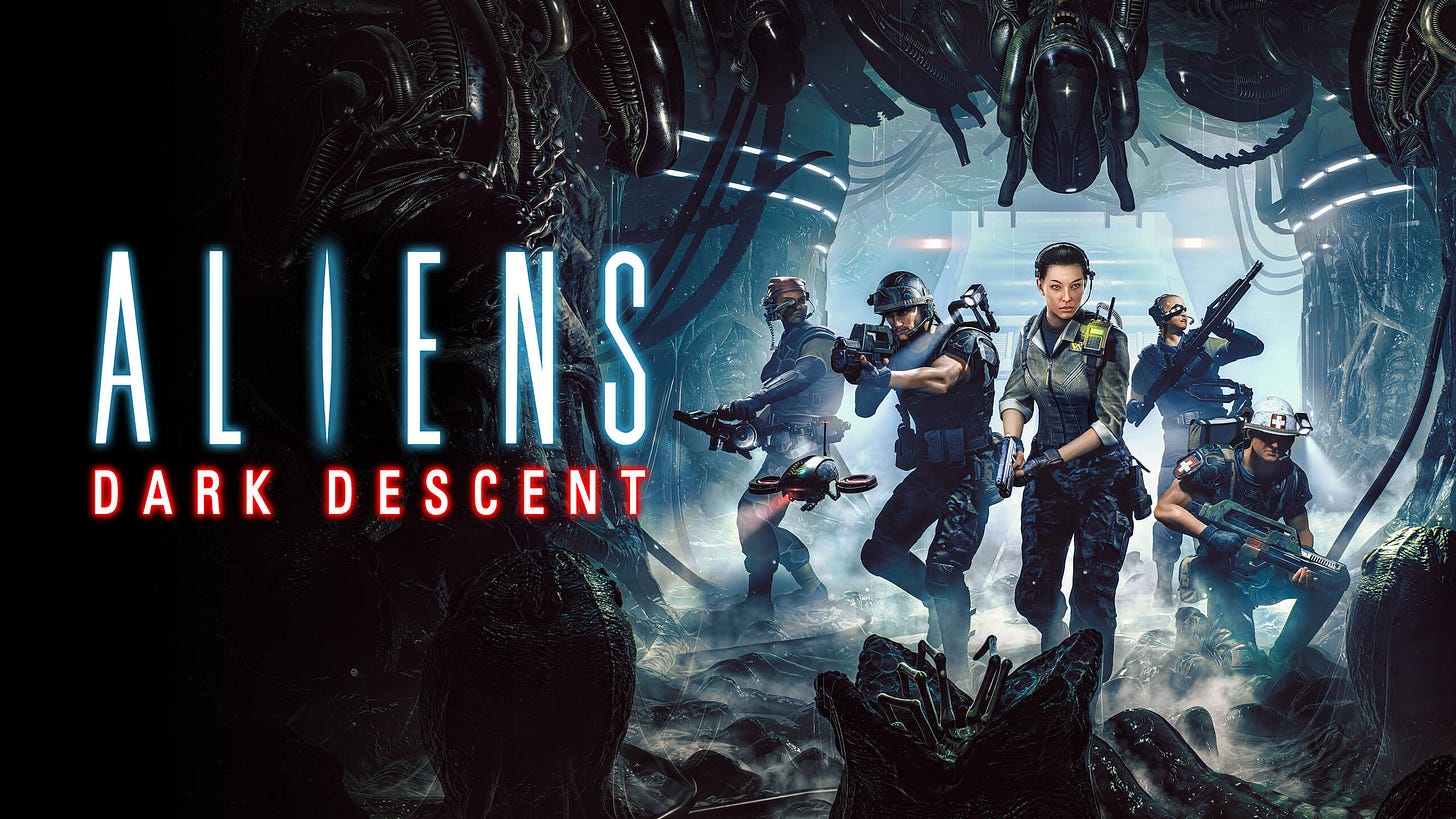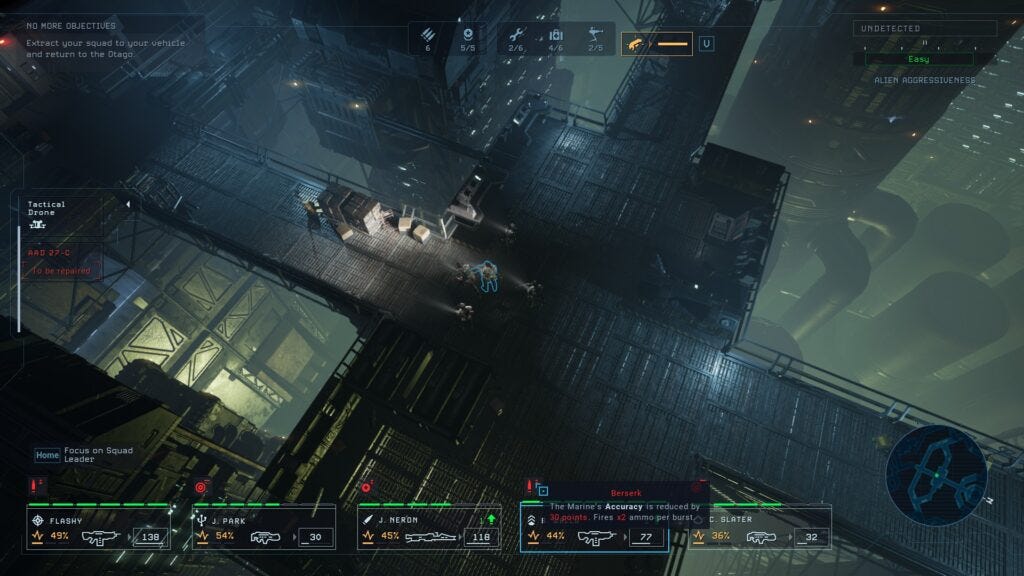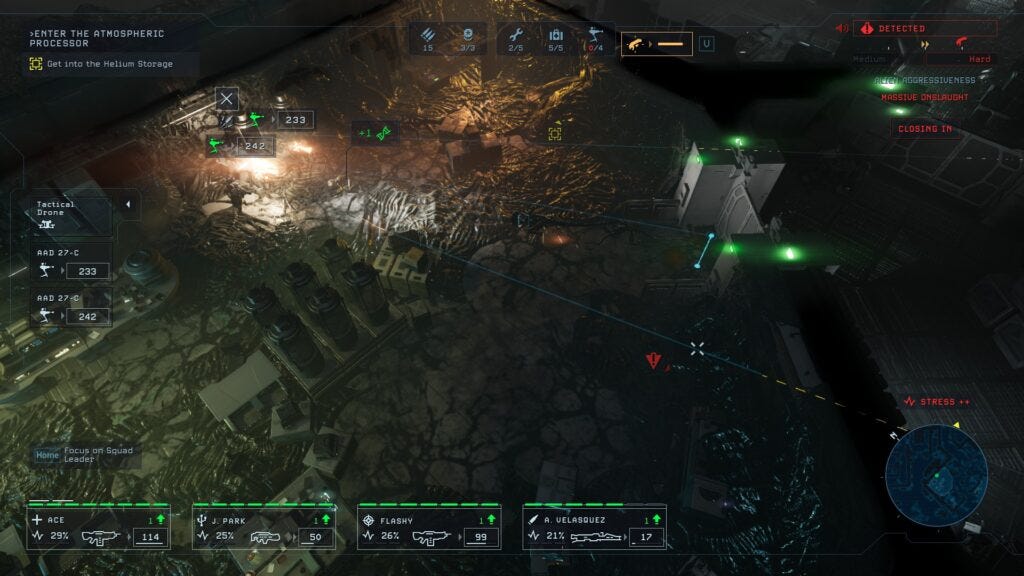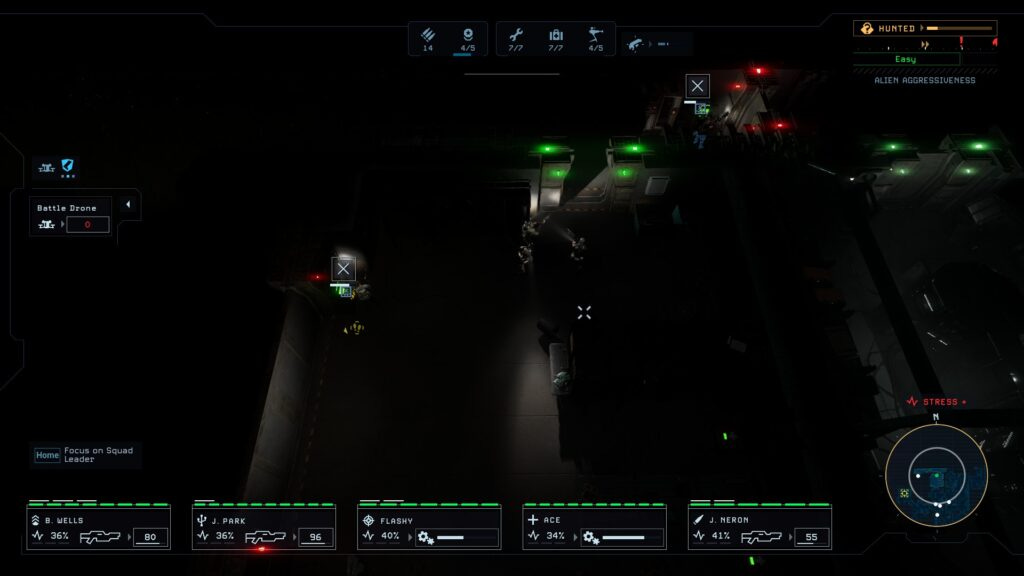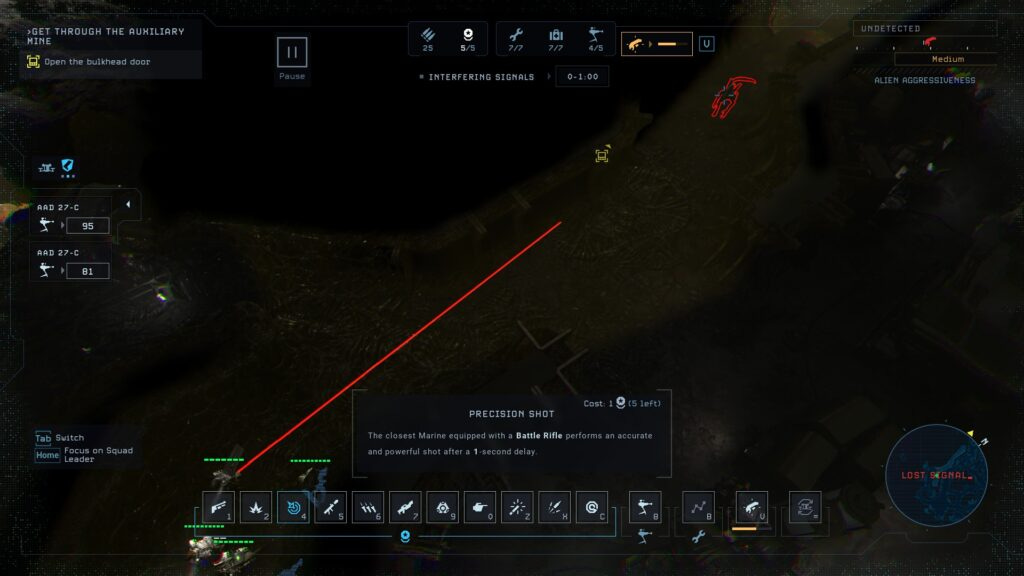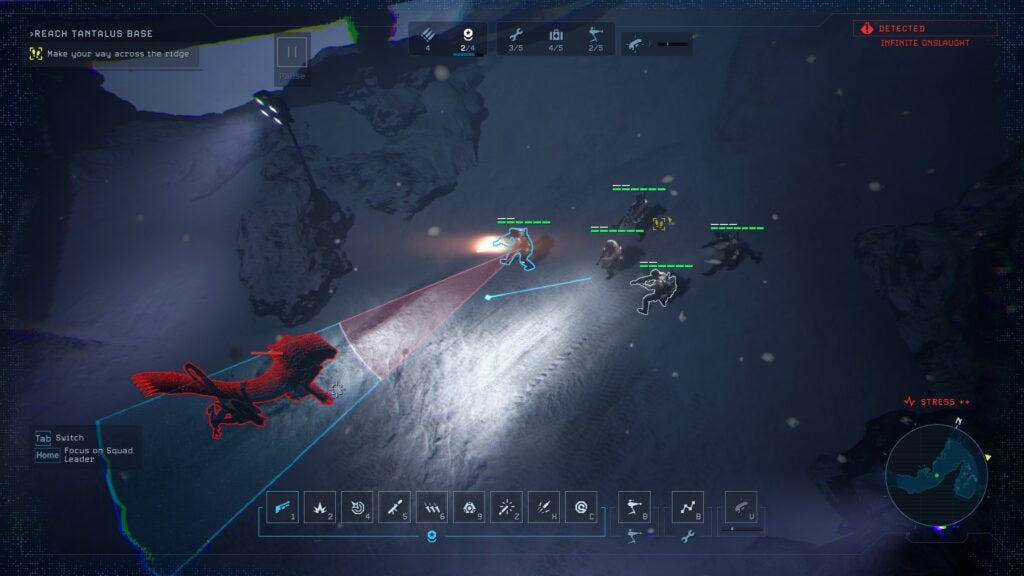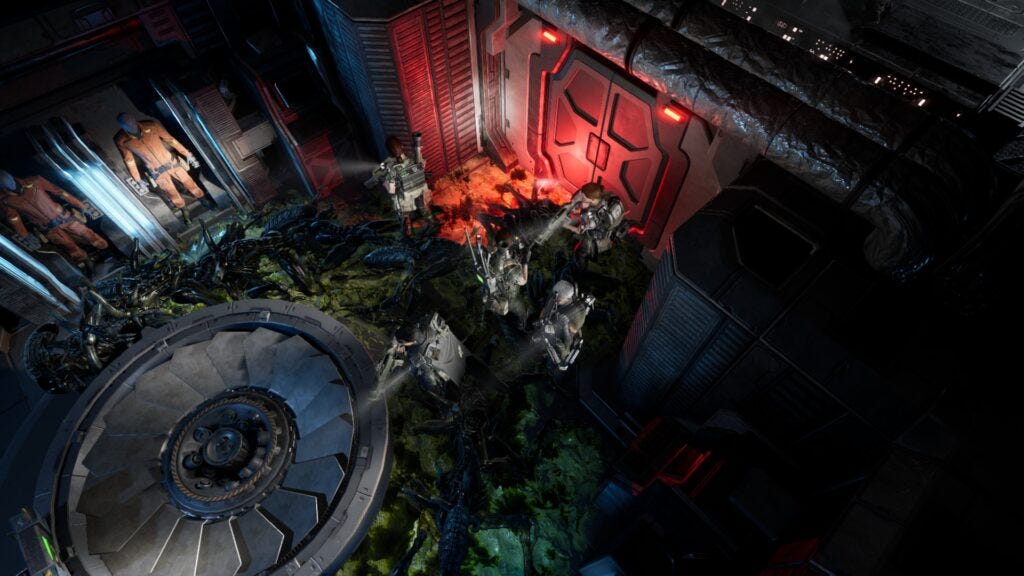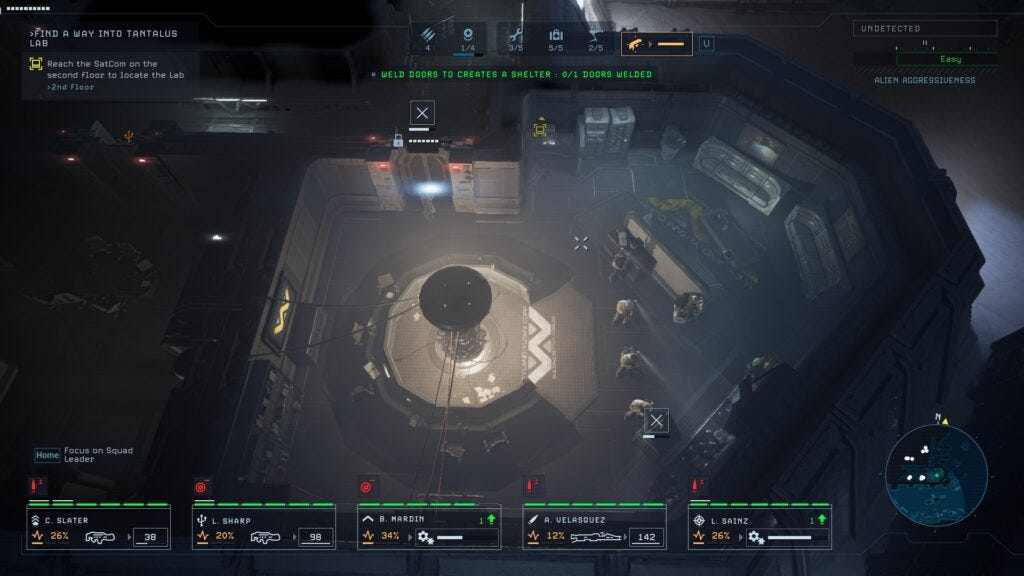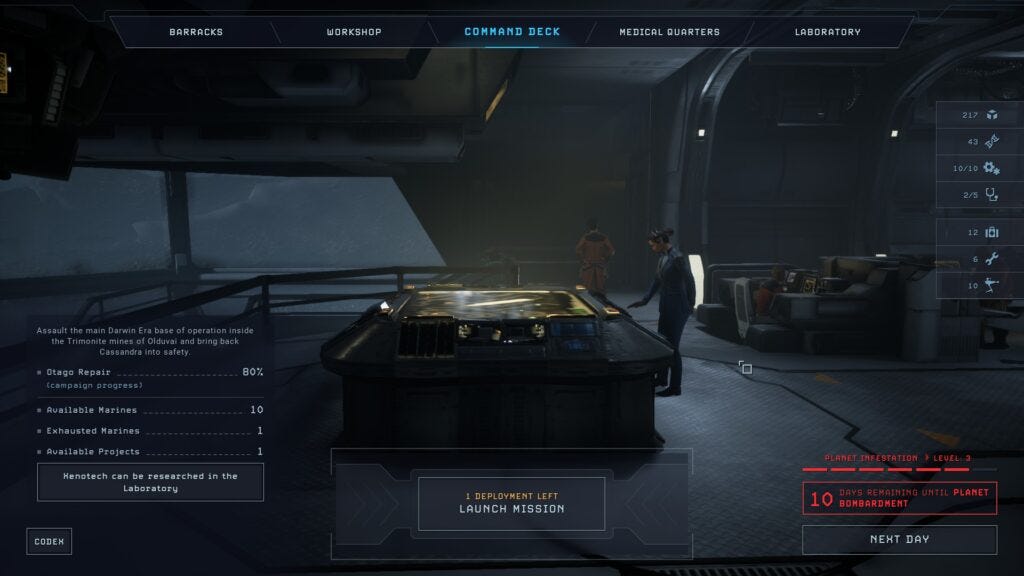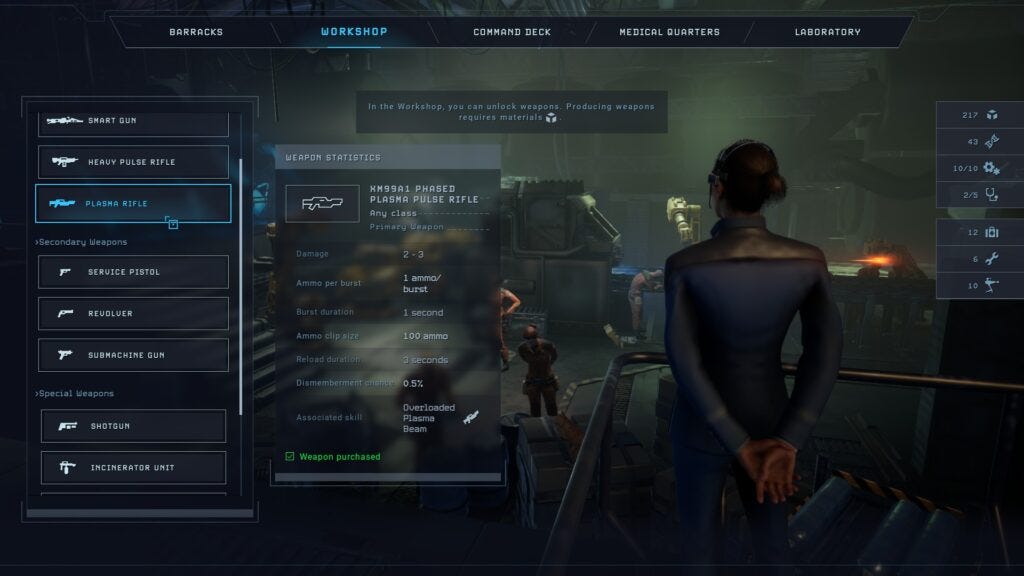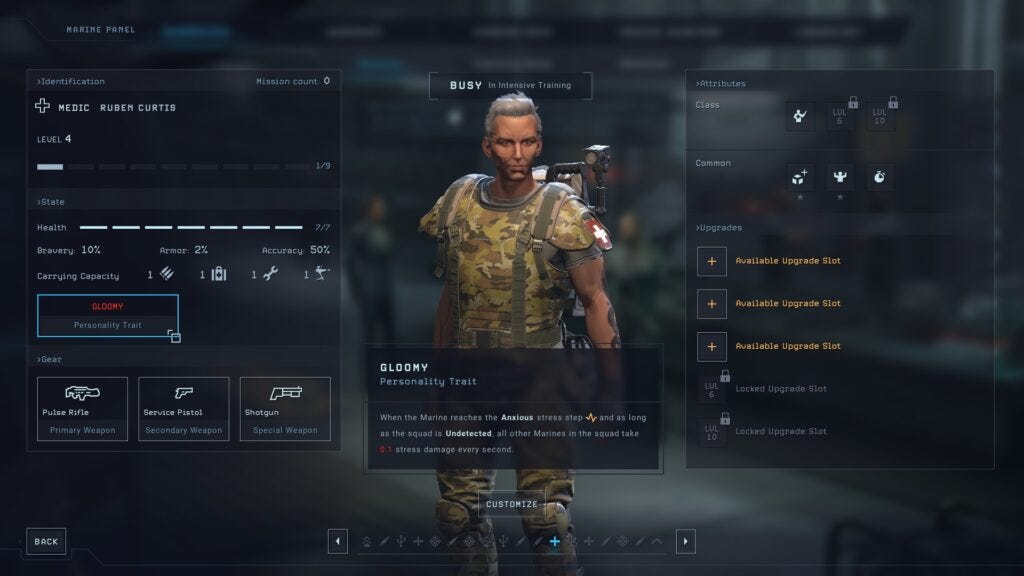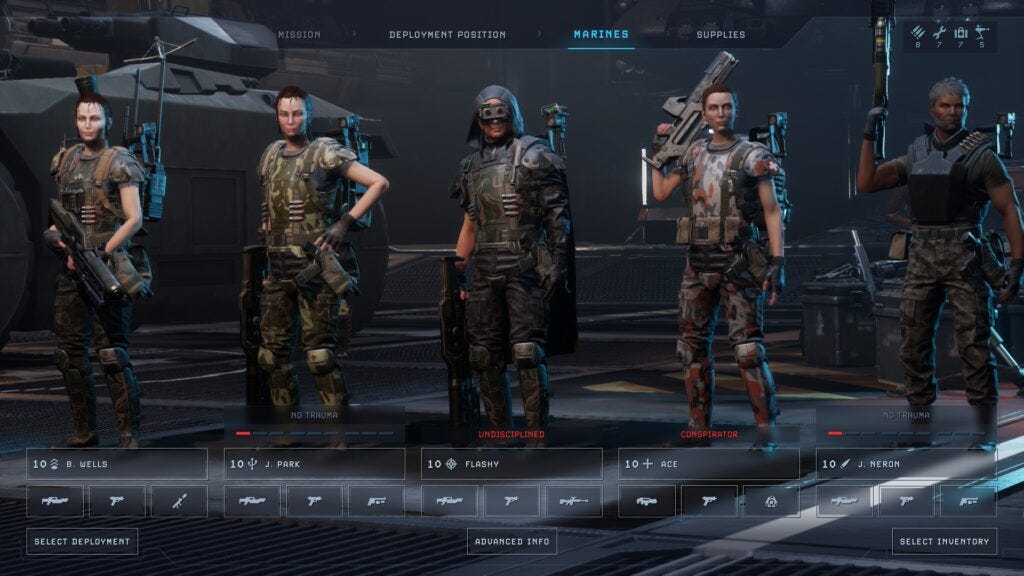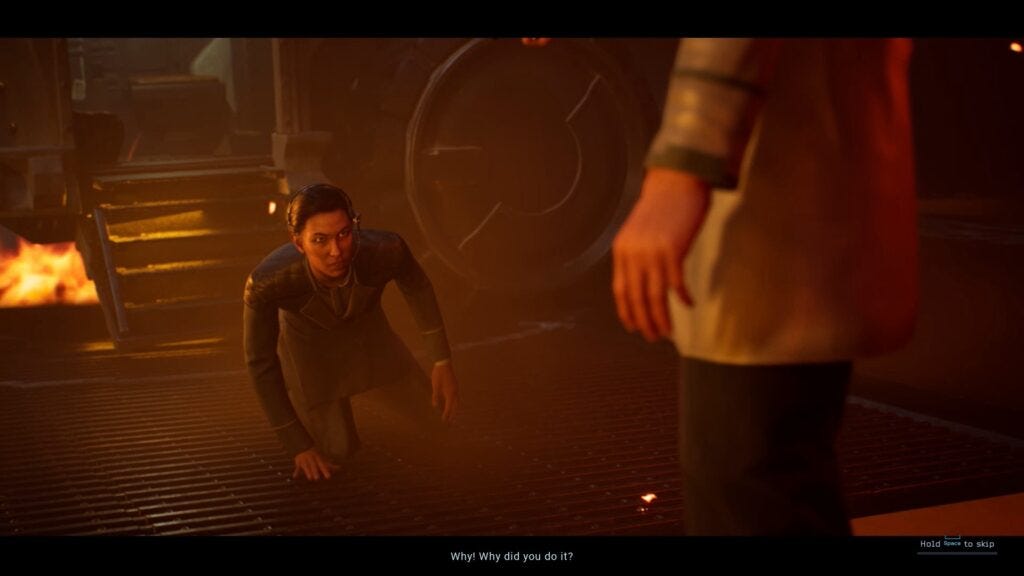Aliens: Dark Descent has too many problems to list. Not small issues, but serious design flaws. The gameplay lacks fundamental features that needed to be included for any game attempting survival horror-tactics like this. The narrative components are poorly written, poorly translated, and poorly paced. The game festers with serious and often progress-impeding bugs, and large amounts of patching will be required over the next few months.
All this together should be disqualifying. These things should make Dark Descent, at best, a mediocre AA game, hardly worth $40. This should not be an experience worth your time.
These are the things Aliens: Dark Descent should be. From a distant vantage point, as I mull over the notes from my playthrough, I can’t imagine any game with so many fundamental issues being more than tedious and aggravating. They should be disqualifying. This should not be a good game.
Yet should isn't is. What Dark Descent is is significantly more than the sum of its parts. What it is is relentlessly engaging and thoroughly unique. What it is is the game I was unable to put down for twenty hours straight, which has consumed my thoughts for the last three days. I still regret that it's over.
Aliens: Dark Descent is not mediocre. Despite so many flaws, it may even be brilliant. It represents the best Alien game since Isolation nine years ago, and enters the pantheon of must-play games for fans of the films (alongside AvP2). But when you sit down to play, be ready to grapple with some frustration, and don’t forget your Raid Bug Spray—for aliens and technical issues both, you’ll be sure to need it.
An X-COM ImSim?
In Aliens: Dark Descent, the player takes control of a small squad of United States Colonial Marines who have crash-landed on the planet Lethe, which is both overrun with xenomorphs and coincidentally looks exactly like LV-426 from Alien and Aliens. Balance resources and the wellbeing of your marines against a doomsday clock as you struggle to repair your ship, the Otago, over the course of eleven persistent-world story missions.
The bird’s-eye perspective of Dark Descent will make it sound like an X-COM clone. A class-based strategy game about managing a clock, customizing and taking care of individual soldiers in and out of the field, while juggling an overworld campaign and the realities of day-to-day military operations.
The metagame might as well be a simplified version of X-COM: Alien Invasion. Managing your soldiers’ health, giving them new names and haircuts, researching gear, buying guns, and investing in equipment: the influence is undeniable.
But the rest isn’t an X-COM clone like WH40k: Daemonhunters at all. Instead it is a pauasable squad-based real-time tactics/stealth game in the vein of the Commandos series or Shadow Tactics: Blade of the Shogun. Dark Descent’s main innovation is that the squad is always controlled as a single entity; an AI system will determine which marine is best suited to perform any individual task when the order is issued. You are never permitted to split the squad otherwise.
Most of any mission is spent sneaking through a colonial facility or space station while attempting to avoid xenomorphs or human enemies. Directly engaging in combat causes each marine to individually generate Stress, which slowly accumulates into debilitating debuffs if not reduced through pills and resting. Of course engaging threats directly also risks death, as xenos will begin Hunting the player down after even a brief encounter with a single drone, leading to raised Hive Alertness.
You can think of this like an alarm in Metal Gear Solid, with a punishing twist: if Hive Alertness gets too high, the aliens on a map will become more aggressive, and special elite xenos—Crushers and Praetorians, which should be familiar to any player of Colonial Marines 13-- will spawn in to track you down.
Detected. Hunted. Onslaught incoming. Better find a chokepoint.
This feeds into the other primary innovation of Dark Descent: each mission is persistent. The scarcity of resources such as medkits, toolkits, and ammunition, as well as the ever-increasing difficulty of the aliens on a map, incentivizes the player to withdraw before completing every objective. Once withdrawn, your squad can rest, recover HP and mental Trauma accrued from Stress damage, refit their gear, or swap out with different marines entirely for a second run. Or third run. Or fourth run.
You can complete missions as quickly or slowly as you see fit. If things get too intense, head back to the APC and bug out; the level will be there tomorrow. The catch is that the Wey-Yu space station in orbit is set to launch nukes at the surface in 28 days: run down that clock, and the only thing that’s going to be left of the Otago is a smear on the side of an asteroid.
Prowling around dark, atmospheric, and persistent levels while staring at your motion detector, evading xenos, looting crates, and searching for text logs is what leads me to describe Dark Descent as a strategy/tactics game take on the Immersive Simulation formula. The levels are open-ended, generally featuring redundant and alternative paths for your marines to take while ducking into cover and avoiding patrolling xenos. The game feels a lot like System Shock or Aliens: Isolation levels as viewed from a security camera's perspective. It could also be viewed as a survival horror game fused with the RTT genre, although the focus on character progression tilts the scale toward ImSim for me.
Shortcut unlocked.
While sneaking around, you’ll always have support from the APC. With it you’ll be able to extract your squad or redeploy elsewhere on a level, safely rolling past any drones on patrol. The APC can be controlled indirectly from the map screen and sent to various pre-determined positions throughout a level. Its turrets wreck xenos, and watching it light up an approaching horde over the course of a few seconds is immensely satisfying. Using the APC as fire support is one of the most enjoyable features of Dark Descent, and I wish the player had more control over its movement.
But while the primary gameplay loop is both fundamentally solid and a unique fusion of several different types of games, it is far from perfect. The total inability to micromanage individual marines was clearly intentional—there’s a loading screen tip that states this outright—but often creates frustration and pointless confusion. For example, Recon marines can learn to use a sniper, and this sniper can be outfitted with a silencer. This is the only way to take out patrolling xenos without alerting the hive, and is hugely useful during the stealth phase of missions.
But you aren’t even permitted to change the marching order of your squad while deployed, and when ordered to use a special ability, marines won’t path to a location as they would in similar games. This ultimately leads to the bizarre situation where I have to march my entire squad out into the open, allowing myself to be detected, as I maneuver my Recon to a spot where he’ll have line of sight on the target I want neutralized. If the Recon is in the party’s rear, you might have to step your entire squad all the way out in front of an approaching drone until he can take his shot, at which point it will be too late.
When you're a world-class special forces xeno killing operative, but can't figure out how to move two inches to the right.
Marines also are too stupid to aim at xenos with their special weapons. The shotgun, for example, has a widely expanding cone of effect, with two sections to demark different levels of damage. But because of how it expands, and because you cannot target xenos directly but only the ground they’re running across, the shotgun is paradoxically the least accurate weapon at close range—good luck hitting a moving target, after a delay, with two pixels of a shotgun, at point-blank.
This same issue affects every weapon. The RPG seems useful, and can be in a pinch, but your marine will not adjust her aim once the order to fire has been given. So if that Queen moves slightly to the left, you’ll miss. Combined with how awkward maneuvering individual marines is when you can only control the squad as a single entity, I can’t help but think that some amount of autoaim would have been appreciated.
For if xenos get close. But not TOO close!
Beyond the RPG, shotgun, and sniper rifle, special gear consists of mines and flamers. These aren’t weapons the marines will make use of themselves, but special attacks that can be queued up using Command Points, a regenerating resource that is expended on abilities. I found Command Point skills to be useful throughout the entire game, and always satisfying. But, at least on Normal, they were practically infinite. By the time my Squad Leader hit level ten, I could never expend them all in a single fight. Even if I did, they would all be back in the blink of an eye. The balance never seemed right. Some kind of ordinance resource to limit use of mines and grenades would have made sense; as it is, you can spam both infinitely.
Combat itself is not complicated. Once detected, the squad will open fire on any xenos in sight. You can place Suppression cones for a Command Point in a single direction, but the most you’ll be able to do thereafter is choose which direction to walk or run in. Marines will fire while waking backward, which means that kiting xenos while juggling weapon powers is about all there is to going loud. This gives Dark Descent’s combat sections a Dawn of War 2 kind of feel, and I wonder how much the game would change if you were given three or four squads to manage at a single time; I doubt it would be too much to do.
The simple ability to split your squad within a small radius around the Leader via a special ability would do a lot to make the game feel less like a kiting simulator and more like an actual tactics game, and there are places in the campaign--especially when dealing with human enemies--where the lack of such an ability feels less like intentional design and more like an oversight.
Some of the strongest sections are about point defense, a bit like last year's Starship Troopers RTS, where you can set up sentry turrets. See Fort Sentry pictured above. But at times like these, the inability to individually position marines for maximum efficiency is the most severely felt. Splitting the squad to opposite sides of a barricade, for example, could help reduce xeno acid splash damage in emergencies--but such a thing is not permitted.
I similarly feel like the stealth mechanics aren’t developed enough to warrant their overall importance. Avoiding xenos whenever possible is vital to keeping Stress and Hive Alertness low; these are the game’s real killers. But when it comes down to it, there are no stealth mechanics except for monitoring blips on your Motion Detector, keeping out of LoS, and making use of the silenced sniper whenever possible.
That’s it. There’s nothing else to do.
While I appreciate Stress and Alertness as mechanics in theory, they cascade together in the perfectly wrong way for a stealth game. Being spotted leads to combat, which causes Stress; combat leads to being Hunted, which generates Stress until the hive gives up; being Hunted leads back to combat, which leads to Stress; being hunted also generates Hive Alertness, which leads to increasing difficulty and further combat.
In other words, you’d better not get spotted. That would be fine in a stealth game—but is a real-time tactics X-COM clone with two and a half stealth mechanics really a stealth game at its core? Its incentive structures say it is, but the mechanics disagree.
In any case, Hive Alertness is frustrating and overburdening, but Stress can be dealt with easily. The primary method of both saving the game and reducing Stress is through welding your squad into a room that xenos can’t reach, then resting. This costs between one and four toolkits, and reduces between 90 and 150 Stress, depending on the traits your marines have. resting can also regenerate HP and ammo with the right perks.
I’m not sure that chilling out for an hour in a tin can while xenos skitter around inches beyond the door would be the most stress relieving experience, but then I’m not in the USCMC.
Let me chill out for a sec in this acid bloodbath. It really hits the spot.
The resting mechanic makes toolkits vitally important to long-term success and gives a strong structure of play to the game. Get spotted, find tools, weld yourself in a room, repeat. You’ll always be on the lookout for dead-ends and storage closets that will make for good safehouses. This is one of the primary ways the game cultivates its excellent sense of tension.
But the punitiveness of interactions between combat, Stress, and Alertness might make resting too important overall. At one point in the game, when I found myself with plenty of toolkits and five marines near 300% Stress, I simply welded, rested, unwelded, welded, rested, unwelded, welded, and rested again within a single room; I thus found my squad back up to 100% in all respects except armor, which can’t be regenerated mid-mission. There is no penalty in this scenario for causing such a huge delay. Survivors on the map will never be abducted by xenos when you aren't looking and objectives will never time out.
A definite mark in the game’s favor in this regard is that many levels feature human enemies. These encounters turn Dark Descent from kiting simulator to cover shooter, lending much-needed variety. More importantly, humans lack Alertness, and don’t Hunt the marines after a fight. Stress will still be generated when human enemies are engaged, but these occasional firefights break up the monotony of rest spam, and let off some of the game's immense tension. It’s a huge relief when you come onto a room filled with cultists, launch a few grenades, exchange shots from cover, and suffer no further consequences (except, perhaps, a point of damage or two).
I completed the game with nine days remaining, finishing most levels in a single deployment. Without knowing how many missions there were in total, I felt extreme pressure not to waste any time. This ended up wearing out my highest level marines more than was needed, but saved me a few days in the long run. Since each day passed also adds to the hive difficulty by one point, I’d say I made the right choice.
The lack of a manual save feature would seem to suggest that Dark Descent wants to be played ironman, like any X-COM clone should. But I found the imprecise controls and immensely punishing outcomes for high level marine death to make this an impossibility in all but the most minor of circumstances. In X-COM 2, losing one of your best soldiers feels horrible, but improved armor and weapons make catching up underleveled squaddies less daunting than it might otherwise be.
In Dark Descent, gear is also tied to marine level. Only level 10 marines, for example, can make use of the ludicrously overpowered plasma rifle—even after it’s been researched. Since lower level marines also lack important skills for survival, a deployment of five level one marines into mission 11 isn’t much more potent than a deployment of four level one marines in mission 1. They will be using the same gear, with perhaps slightly improved armor from xenotech.
The overall upgrade scheme of weapons is excellent despite this small pacing issue. While the plasma rifle’s destructive capabilities are obscene, the other weapons are never directly better than what precedes them. I made sure at least one marine still had a basic M41-A even in the final mission because of how useful its grenade launcher was. The Heavy Pulse Rifle is better than the M41-A, but is it an upgrade worth your UGL? Hard to say, which makes it a compelling decision to make.
We got tactical smart missiles, phase-plasma pulse rifles, RPGs, we got sonic electronic ball breakers! We got nukes, we got knives, sharp sticks...
The various other weapons aren’t quite as compelling. No more than one marine needs to carry mines, and the flamer is utterly useless (at least, I found it to be). The shotgun remains king throughout the entire game. Sidearms, also, are entirely pointless; I used them three or four times in total. The SMG did not prove worth the 200 Resources I paid for it.
The marines themselves are much like X-COM’s soldiers, with a suite of customization options, classes, and individual perks. Class-specific level benefits are unlocked slowly and require a monetary investment, while general character perks are earned each level. These are things like +HP, +Accuracy, +Crit Chance, or the one-time removal of the marine’s base negative trait.
Yes. Every marine begins the with a single negative personality trait. These range from minor— “minus one HP” or “starts with one fewer magazine”—to unbelievably punishing, such as “steals twenty resources at the end of every mission,” or, “deals one damage to a friendly marine while resting.”
I can appreciate what the developers were going for, but the fact that literally every marine has a negative trait, and that some of these seriously disrupt a mission, I think they went overboard. These traits can be removed upon level up, but only with a degree of luck: the perk options a character receives are random.
This system would have been stronger if the traits changed the ways a marine acted in more ambivalent ways, conferring some advantage while also carrying with them a penalty. As it is, you can guess that the guy who dealt his friends damage never got to go on any missions.
As marines go on deployments, they’ll also accumulate Trauma. Trauma has various effects, but is always negative, and generally works similarly to traits. This works much better in the game overall, because Trauma can be managed through time spent in the Psych Ward. It’s a strong incentive to scatter marine eggs throughout as many different baskets as possible, to make sure that your best characters will always have enough time get back on their feet between important deployments.
The classes are Squad Leader, Recon, Medic, Tecker, and Gunner, and do what you would expect. Each marine is promoted to one of these five roles at third level. I like the customizability of the squad overall, but I would have preferred weapon and armor upgrades more along the lines of X-COM 2: with the exception of the Gunner, every class uses the same main weapons; and with the exception of Recon, they use the same side and heavy weapons, too. Class restricted shotguns, DMRs, and explosives to be used as primary, rather than Command Point-only, weapons would do a lot for variety’s sake over the course of a campaign, and add in some much-needed differentiation between the classes. As it is, they might look different, but they feel mostly the same.
Absolutely badasses!
Dark Descent is trying to do a lot. The designers have combined three separate genres into a single cohesive experience. It features the combat of Dawn of War 2, the stealth of Shadow Tactics, and the campaign management of X-COM 2, and synthesizes them together into something new. It does this remarkably well.
Yet it feels like the game could stand to do even more. More complexity. More resources. More control over individual units. More mechanics for stealth and maneuvering. Sprawling as the experience already is, I want more.
But it’s telling that, despite listing so many gripes with the game, I never was seriously frustrated or annoyed with Dark Descent. If I felt I was unfairly spotted, or that a death wasn’t warranted, or a level’s layout didn’t make sense, an autosave was never more than five minutes back. I wanted so much more out of this game, but what is there works well enough that nothing more is needed. The only real source of aggravation over the course of my playtime was that there's no way to lock doors open--that is the one thing that I think desperately needs to be patched in.
So Dark Descent could be better. I have high hopes for a sequel, and the possibilities seem limitless: a DLC about returning to Hadley’s Hope; a standalone expansion where we play as WY PMCs; a sequel that does everything the same, but works in so much more. As a series, the idea of this game is incredibly exciting.
But even as a standalone game, it works. It’s a tense, engaging, and unique experience. I want more. I want to keep playing, and the moment I’m done here, I’m going to launch a second campaign on Hard.
Aliens: Dark Descent is a must-buy for Alien fans, and I’d recommend it to anyone who enjoys real-time tactics games and X-COM clones. The campaign is long and stuffed with content; it took me over twenty hours to complete everything, and I could have gone much slower. And while its $40 price tag goes hand-in-hand with AA quality and technical issues, at that price, it’s still more than worth it. So long as you’re willing to grapple with occasional crashes, rough performance, clipping, and graphical glitches, I would absolutely recommend this game for full price.
There is one problem I haven’t yet mentioned, though.
The Story
A bit like Daemonhunters, Dark Descent features a prominent linear narrative. You assume the role of Maeko Hayes, the deputy administrator of a space station around Lethe in orbit, and follow her as a player character throughout the campaign. She’s controlled directly during a handful of missions, as well as the tutorial, but otherwise plays the role of “the Commander” in X-COM.
Maeko’s sections of the game are very weak. Her prologue is borderline awful, and the rest of her missions are even worse. I don’t mind the idea of injecting personality into the Commander character, but her degree of importance in the plot—as a minor administrator—creates dissonance with the gameplay, and leads us to what is Dark Descent’s worst quality: its narrative.
The Last of Us on PS3 is renowned for its story. I launched this blog to complain about its sequel almost three years ago. And if you tally up every pre-rendered cutscene in TLoU, the total runtime comes out to about ninety minutes.
If you do the same for Aliens: Dark Descent, the total runtime is over one hundred minutes.
Aliens: Dark Descent does not have 10% more story than The Last of Us.
An impressive amount of money and effort has gone into the narrative. Every line of dialogue is voice acted, and the cutscenes look incredible for a AA production. Care has been taken. The developers wanted their game to match up to the big leagues.
There’s one thing they didn’t put time and care into, though: the writing.
The developers are French. It shows. The game’s script is riddled with bizarre dialogue that could only have been written by a non-native speaker of English. While the dialogue isn’t as cringe-inducingly unbearable as a Mass Effect: Andromeda or Forespoken, it has a different, uncanny quality that I found impossible to endure, as well as countless cringe-inducing verbal references back to the old movies. In small doses it might have been tolerable, but there’s so much, always in your face, always distracting from the gameplay, that I had to resort to skipping as much of the story as possible. It would have been a dealbreaker if I hadn’t been able to.
Beyond endless melodrama, every character refers to the aliens not as "xenos," but "critters." This makes Dark Descent the second Eurojank game I've played this year that endlessly uses this word, despite it being almost never said unironically in the US.
Beyond being overlong and poorly scripted, the plot is crammed with tired tropes and ridiculous cliches, and ultimately tells a story more reminiscent of Luc Besson than James Cameron. The third act especially is so ridiculous that I was laughing out loud at every line of dialogue, and the final confrontation is almost a parody of the franchise’s creative staleness--ironic, considering Dark Descent's mechanical originality. The story is so ridiculous and poorly done, with such high production values, and it takes itself so seriously, that it borders on “so bad it’s good.”
Unfortunately, that’s not what I wanted from an Alien game. But oh well. A strong narrative would have been a huge boon to Dark Descent, but a bad one is a fairly minor ding. It’s a strategy game at its core, and you should play it for its strategy gameplay—not its story. The atmosphere is otherwise strong, and the designers clearly had a good sense of the property. That is a good thing when it comes to sound and art design, but may just be the problem when it comes to narrative.
I’m hoping they might do a better job with a sequel, or their next entry to the same franchise. Like, maybe they’ll hire someone who speaks English as a first language. Someone like me. I’m available. Hire me to do it. Please. I will write you the most kickass Aliens story you've ever seen.


